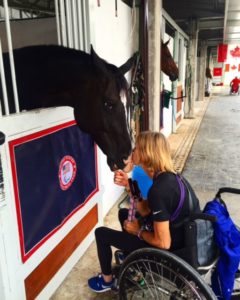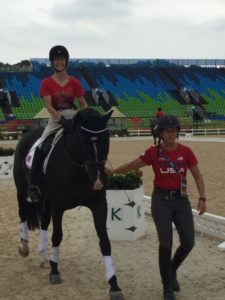How one world-ranked equestrienne learned to set new goals as a Paralympian
Three-day eventing is an equestrian sport that achieves its synchronicity between a horse and its rider through a combination of calculated precision and jeopardous speed.
This Olympic equestrian discipline consists of performing a flat and graceful dressage test, followed by the adrenaline-charged challenge of completing a series of jumps across a cross-country course. The competition concludes with show jumping over fences.
Paralympian Margaret “Gigi” McIntosh, now 65, had been competing at the Concours Complet International level since the 1980s, when she brought a new horse to the 1999 Morven Park Spring Horse Trials in Leesburg, Va. The fall that changed the course of her life happened when her horse got its hind legs tangled on a cross-country fence and she fell chin-first, breaking her sixth vertebra and resulting in quadriplegia.
Some riders would have retired, but after six weeks of rehab and several more years of riding just the right horses, she not only adjusted her expectations but also excelled.
Competing on the world stage, McIntosh always had to set another goal and prepare for the next event. She admits she was, at first, ill-equipped to embrace her paralysis as part of her riding.
“I had ridden almost every day of my life before my accident,” she said. “Still, I never imagined that I would not, somehow, get back on a horse.”

Making Adjustments
To do that, McIntosh had to forgo athleticism for determination.
“My legs stuck out from the sides of the saddle, and I had a hard time cantering,” she said. “My right leg would have a spasm and shoot forward, so I wasn’t able to keep it on the horse, but I thought through practice I should be able to make that better and not have to use special equipment.”
She said that when she got “the bug” to compete again in 2010, Missy Ransehousen, a 1995 Pan American Games silver medalist, changed everything.
“She tied my feet to the stirrups, and the stirrups to the girth. Having my legs more stable, gave my upper body a lot more mobility, and I was able to use both reins in a more normal way,” McIntosh said.
“Missy also adapted the saddle with external knee rolls, and a higher cantle, so I was drawn deeper into its seat. On my horse, Hobbs, I was even able to manage canter half-passes,” she said, referring to the dressage movement in which a horse moves forward and sideways at the same time.
“A big part of working with a horse or a rider is to find out where their biggest strengths are,” Ransehousen said. “Once they adapt to the new way their body works, para athletes never really slow down.”
With the help of Ransehousen, who has served as a coach to the U.S. Paralympic Team for 18 years, McIntosh achieved what she did not think was possible. McIntosh took her horse, named Rio Rio, to the 2016 Paralympic Games in Rio de Janerio.
“Hobbs had a great trot, but he had a terrible walk, so Missy found Rio Rio,” McIntosh said.
In the Paralympics, dressage tests are ridden at a walk, and riders are given a grade that determines the amount of points their rides are worth to the team. Historically, these classifications were based on medical conditions, such as spinal-cord injuries.

In the equestrian arena now, athletes with different disabilities are grouped together and instead of riding horses from the host country, riders bring their own.
“I was definitely still competitive and lucky to find a great way to channel my drive,” McIntosh said. “I had to learn that nothing was going to be the same way it was, but that I could still enjoy a bonding experience with my horses and coach. The important part is how much the horses contribute. They have to be copacetic to what’s going on in people, like inadvertent spasms, but it gave me incentive to get stronger.”
Setting New Goals
Only after being named an alternate for the 2018 International Equestrian Federation World Equestrian Games in North Carolina did McIntosh decide to work specifically on making her back comfortable instead of focusing so much on competing.
“My back was painful,” she said. “And although I don’t ride anymore, I still work out, and I am in awe of the many opportunities afforded to people with disabilities these days.”
In the fall 2019, McIntosh lived another lifelong dream to visit and hike up Machu Picchu in Peru.
“Our guides were very knowledgeable and strong enough to carry me in my wheelchair,” she said.
She also returned to her hobby of skiing, which puts less pressure on her spine.
“I don’t have to sit, and much of it is muscle memory,” she said. “I can’t do a snow plow, but I can do a hockey stop to control my speed.”
With her other love of traveling restricted by the novel coronavirus (COVID-19) pandemic, McIntosh said her impetus is trying to stay fit.
“The pandemic and retirement shifted my motivation from the horses back to me,” she said. “My personal trainer meets me online for strength training, and I have a Peloton subscription. I am also in a program at Reading Hospital Rehabilitation near my home in Pennsylvania, where I use a 50-pound exoskeleton that guides my legs in a normal walking pattern.
“I was lucky to pursue my dream in my new situation. But what I know now is that I can set goals anywhere.”
To learn more about Margaret “Gigi” McIntosh’s journey, watch the mini documentary A Fork in the Road on YouTube, or visit https://www.gigimcintosh.com.